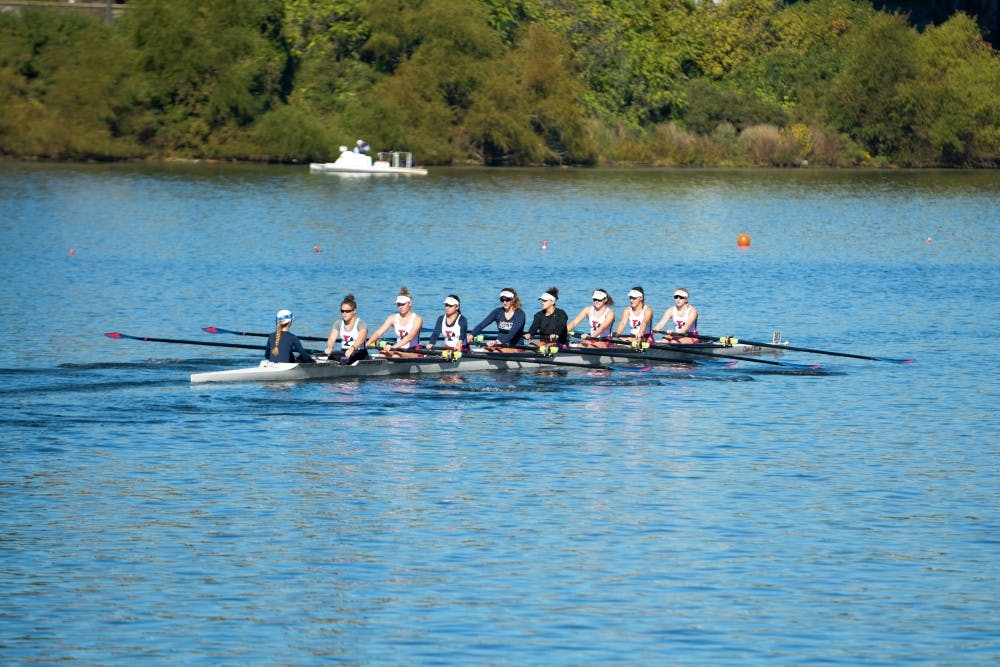
In the Navy Day Regatta, Penn women's rowing's 1V boat cruised through the 5,000-meter race, besting Navy and Drexel by almost 30 seconds.
Credit: Mark Shtrakhman“It’s game on at this point.”
Colin Farrell, head coach of the men’s lightweight crew program, was optimistic about the coming season after Penn rowing made a statement Saturday morning at its first regatta of the year.
Ideal conditions on the mighty Schuylkill River found both the women’s and lightweight men’s 1V (or “A-team”) hulls finishing first at the annual Navy Day Regatta in a field that included Delaware, Temple, Drexel and Navy.
The women’s team’s fastest eight-sweep (one coxswain and eight rowers, one oar apiece) crossed the finish line in 14:21.77, an impressive time for the lengthy 5,000-meter race. Navy trailed them by nearly 30 seconds and Drexel finished third, only seven seconds ahead of Penn’s 2V hull.
The men’s lightweight 1V hull, meanwhile, was the only eight-sweep to break 13 minutes with a time of 12:55.73. Hot on their tail in splits, but not in physical proximity (a race this long and large requires staggered starts) was Penn’s 2V hull, which edged out third place Navy by four seconds.
Farrell described that this first race of the year is always meaningful for the team.
“There’s a lot of pride that goes into racing,” he explained. “When you put on the uni, put on that Penn ‘P’... for the freshmen, it’s their first race ever as a Penn athlete, and that’s a special moment.”
Penn rowing has plenty of new blood to work with this year. The women’s team in particular boasts 11 walk-on rowers.
“There’s still room to learn how to row in college,” Farrell noted. “Our sport is unique in that way.”
“What we coach here is a team culture,” added Julian Mazaira, the assistant coach in charge of training the lightweight walk-ons. “When we have people that follow that culture, it makes it easy to have people assimilate into that team; they want to feel like they’re part of something bigger.”
All healthy rowers, from the novices to the veterans, had the chance to race this Navy Day. The regatta’s name comes not from the Annapolis service academy but from the Schuylkill Navy, a rowing club association chartered in 1858 with a goal of promoting amateur rowing on the river. Currently, there are 12 members, including Penn Athletic Club Rowing Association which has been known to attract elite national team hopefuls.
The regatta itself was first held in 1986, when two Navy League members, retired Captain John Mulhern and Richard Stewart, came up with the idea to support awareness of the Navy and the Marine Corps on the US Navy’s birthday. After initially spanning the 200 meters from Girard Avenue to the lighthouse, the race was moved to the Columbia Avenue Bridge the next year, and over time grew to the 50-event, 2,000-athlete event that it is today.
The fall season marks the start of a unique segment of the crew year. Unlike the spring season, which is marked by short, 2,000-meter races of which rowers usually only take on one per regatta, the coming months are all about building a long-distance training base. Rowers regularly race two 5K’s each regatta, gaining both experience and endurance for when the spring season rolls around.
Though the Quakers are clearly competent long-distance rowers, the real focus is on the long-term, culminating with the Eastern Sprints rowing championship this May.
“I think we’re really about the 2K, that’s really the championship season and the distance that we really truly prepare for”, Farrell said.
With shorter races comes head-to-head racing, and it’s “that drag race style” that makes things all the more exciting.
The Quakers that raced today will be joined by the men’s heavyweight team as the season continues next Sunday in Boston at the Head of the Charles Regatta.
The Daily Pennsylvanian is an independent, student-run newspaper. Please consider making a donation to support the coverage that shapes the University. Your generosity ensures a future of strong journalism at Penn.
Donate






